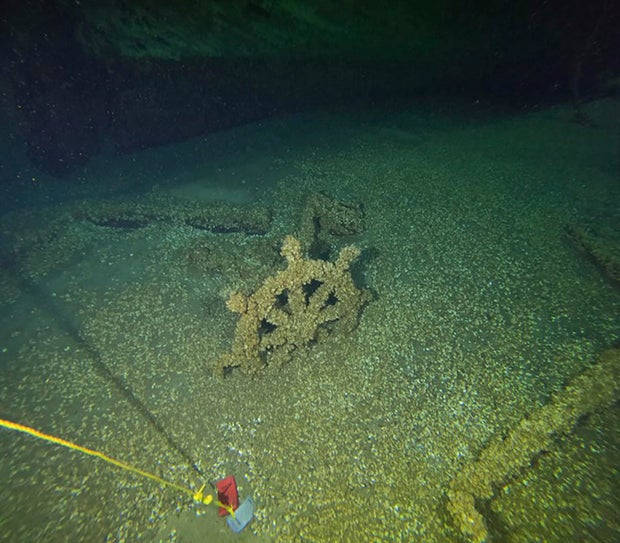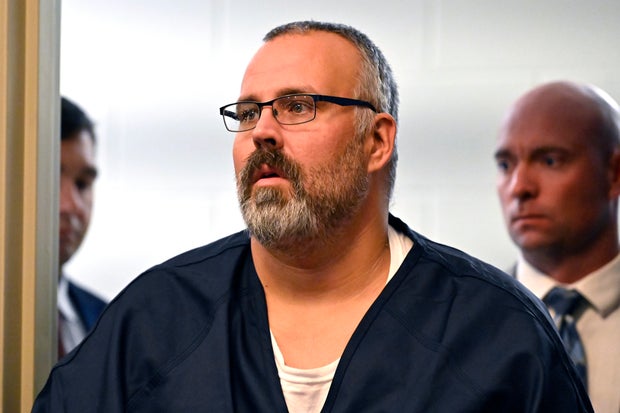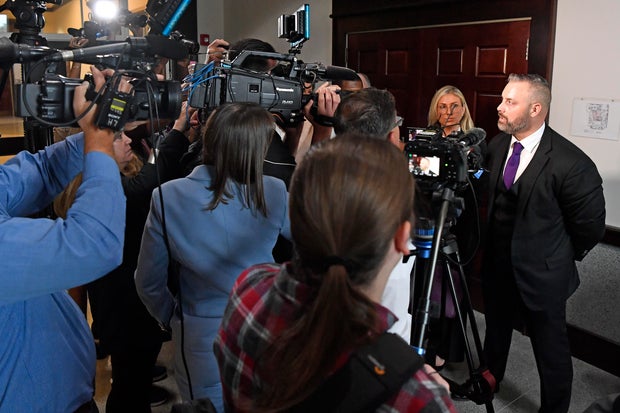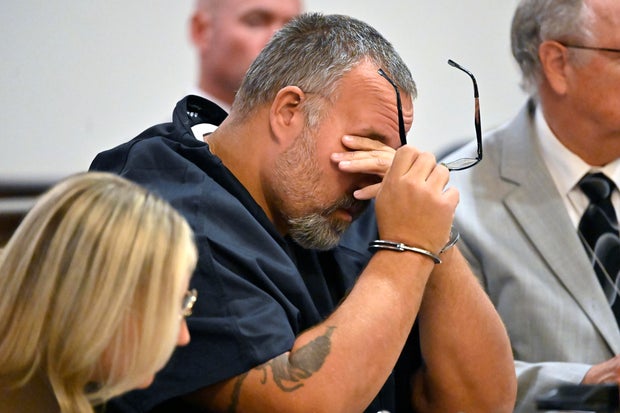CBS News
Effort to map bottom of Great Lakes could reveal location of hundreds of shipwrecks: “There’s a lot we don’t know”

Jennifer Boehme grew up scouting beaches around her home in St. Petersburg, Florida, for whatever she could find. Rocks, sand dollars, coquina mollusks – anything the ocean gave up.
Now, 40 years later, Boehme wants to launch another treasure hunt. As executive director of the Great Lakes Observing System, she’s leading a campaign to map every meter of the lakes’ bottom. The effort, the marine scientist says, will pinpoint hundreds of underwater shipwrecks, illuminate topographical features and locate infrastructure. The map, she says, also will help ships avoid submerged hazards, identify fisheries and inform erosion, storm surge and flooding models as climate change intensifies.
“One of the things that keeps me going is the idea of the discovery aspect of it,” Boehme said. “There’s a lot we don’t know about the lakes. We know more about the surface of the moon.”
Only a fraction of the Great Lakes’ bottom has been mapped, and those low-resolution charts were completed decades ago, according to the Great Lakes Observing System, a non-profit that manages data from a network of lake observers and makes it easily accessible. The National Oceanic and Atmospheric Administration certified the Great Lakes Observing System in 2016 as meeting federal standards for data gathering and management, allowing the federal government to use its data without further vetting.
The organization has been pushing since 2018 to create high-resolution maps of all five Great Lakes bottoms, but that’s a daunting task. The lakes cover 94,250 square miles – an area larger than the state of Kansas. Depths range from 210 feet in Lake Erie to more than 1,300 feet in parts of Lake Superior.
Tamara Thomsen / AP
The idea is gaining traction since technology has improved and scientists have completed high-resolution mapping of Florida coastlines and the Gulf of Mexico over the last three years. Two congressional representatives from Michigan – Republican Lisa McClain and Democrat Debbie Dingell – introduced a bill this year that would allocate $200 million to map the Great Lakes bottoms by 2030.
“I believe it’s time to take exploration and discovery of the Great Lakes into our own hands,” McClain said during a House subcommittee hearing in March.
The last effort to map the lakes came in the 1970s. Maps were largely created using single-beam sonar technology similar to today’s commercially available depth- and fish-finders. The system produced maps covering only about 15% of mostly coastal lake bottom, said Tim Kearns, a spokesperson for the Great Lakes Observing System. With a single sounding every 500 meters (547 yards), the maps were extremely low-resolution and could have missed sink holes, canyons, sand dunes, shipwrecks and infrastructure such as pipelines, cables and intake pipes, Kearns said.
Fast forward nearly a half century. Now scientists and engineers have an array of new mapping tools.
One is multibeam sonar. Rather than sending a single sound wave, these systems bounce potentially hundreds off the bottom. The technology is so sensitive it can detect air bubbles in the water, according to NOAA.
The only drawback is that systems need to be mounted on submersibles or towed under ships to obtain high-resolution images in deep water.
Another tool is laser imaging, where scientists measure how long it takes for a laser beam fired from a plane to reach an object and bounce back, resulting in three-dimensional imaging of bottom topography.
A high-resolution map of the lakebed would offer multiple benefits, said Steven Murawski, a biological oceanographer at the University of South Florida who has done extensive bottom mapping of Florida’s coast and in the Gulf of Mexico.
The Great Lakes map would provide fuller images of bottom features that have changed in the last 50 years due to erosion and shifting sands, giving navigators new depth findings that would improve shipping safety, Murawski said. A map also would help predict how bottom features affect storm surges and flooding as climate change continues, which he said would be invaluable information for insurance companies and municipal planners.
Improved bottom maps also would provide precise locations of infrastructure such as pipelines that have shifted over time, crucial information for dredging and construction projects, Murawski said. He noted he has mapped some 50,000 miles of pipelines in the western Gulf of Mexico and “they’re never where they’re supposed to be.”
Additionally, high-resolution maps would identify underwater outcroppings and ledges where fish tend to congregate, enabling scientists to get better fishery population estimates, the oceanographer added.
“Deadline for our generation”
Fully mapping the lakes for the first time also could reveal the location of hundreds of shipwrecks – some estimates put the number of Great Lakes wrecks at around 6,000 – and relics from ancient coastal civilizations, Boehme said.
Several shipwrecks have already been located in the lakes in recent months. In July, the wreck of the Margaret A. Muir schooner was found off the coast of Wisconsin more than 130 years after it plunged to the bottom of Lake Michigan with the captain’s beloved dog on board.
In April, the Great Lakes Shipwreck Historical Society announced the discovery of the Adella Shores, which sunk to the bottom of Lake Superior with no survivors on May 1, 1909.
Michigan Shipwreck Research Association
That discovery was announced just weeks after the 1886 wreck of the steamship Milwaukee was found more than 350 below the surface in Lake Michigan.
Just a few months before that, a man and his daughter on a fishing trip found the remains of a ship that sank in Lake Michigan in 1871.
Time is of the essence to locate shipwrecks because many of them become encrusted with invasive species, according to the Great Lakes Shipwreck Historical Society.
“The proliferation of invasive species has now created a time deadline for our generation and for future generations; many shipwrecks have already had so many of their features corrupted by mussels that they have become impossible to study,” the organization says.
Though momentum for mapping is building, Congress hasn’t acted on the financing bill since the March hearing before the House Natural Resources Subcommittee on Water, Wildlife and Fisheries. The subcommittee’s chair, Rep. Cliff Bentz of Oregon, suggested during the hearing that proponents do a better job articulating the value of a new map.
“I know ranking members suggested finding the Edmund Fitzgerald would be a valuable thing but there must be more to it than that,” Bentz said, referring to the freighter that sank in Lake Superior in 1975. The wreckage was actually located days after the ship went down.
Bentz’s spokesperson, Alexia Stenpzas, didn’t respond to an email from The Associated Press seeking comment on the bill’s prospects.
Boehme said she doubts the bill will get traction in an election year, but the Great Lakes Observing System is still working toward its 2030 mapping goal. The group holds an annual conference in Traverse City, Michigan, to discuss progress and test mapping technology and has been reaching out to any boaters willing to take mapping equipment out, providing a look at small chunks of lakebed.
“This research is for a public good,” Boehme said. “The key is persistence and going back again and again and making the case (to Congress). … We need to understand the system so we can conserve it.”
CBS News
Treasure hunt trophy worth $26,000 found in Massachusetts, but who is the winner?

BOSTON – A treasure hunt that spanned much of the northeast before being narrowed to the woods of Massachusetts has turned up gold. The creators of Project Skydrop said that somebody picked up the trophy worth $26,000 on Tuesday evening.
Where exactly was the trophy found and who was the lucky winner? That information hasn’t been revealed yet. A map on the Project Skydrop website indicates it was somewhere in a 21-mile radius just north of Amherst along the Route 91 corridor.
Project Skydrop trophy came with big prize
The golden trophy contains a code to access a much bigger prize: A bounty of more than $87,000 made up of entry fees from people who paid $20 for access to special clues for the hunt.
The Project Skydrop website says that in order to claim the prize, the winner must record a first-person video of themselves retrieving the trophy from the woods and then upload it publicly to YouTube. So far, that doesn’t appear to have happened.
Project Skydrop
New Hampshire video game developers Jason Rohrer and Tom Bailey, who created Project Skydrop, haven’t heard directly from the trophy finder yet. But they did talk to a couple who encountered the winner on his way out of the woods, and understand he is a scientist who studied tree habitats as well as sky and weather patterns in images on the treasure hunt website to track down the trophy.
What’s next for Project Skydrop?
The hunt came to an end earlier than the creators expected, and they’ve stopped people from signing up for now. But there is talk of possibly keeping the adventure going with second and third place prizes.
More details are coming soon, according to the Project Skydrop website.
CBS News
Video of Kentucky judge being shot to death shown at hearing for ex-sheriff charged in his murder

Video showing a Kentucky judge being gunned down in his chambers was played Tuesday during a court hearing for the ex-sheriff who is charged in the killing that stunned their Appalachian community.
The short video clip was presented by prosecutors during the preliminary hearing for Shawn “Mickey” Stines, the former sheriff of Letcher County who is accused of fatally shooting District Judge Kevin Mullins on Sept. 19. Stines allegedly entered Mullins chambers at the Letcher County Courthouse in Whitesburg and opened fire, police say.
Mullins, 54, who held the judgeship for 15 years, died at the scene, and Stines, 43, surrendered without incident. Stines stepped down as sheriff Monday.
The video, with no audio, showed a man identified by police as Stines pulling out a gun and shooting the judge as he sat at his desk. The man walked around the desk, pointed the gun at the judge — who had fallen to the floor — and fired again, it showed. Some people in the courtroom gallery sobbed as the video was played, while Stines looked down.
Mullins died from multiple gunshot wounds, Kentucky State Police Detective Clayton Stamper testified Tuesday. Stines pleaded not guilty to murder last week and is being held in another Kentucky county.
Timothy D. Easley / AP
Stines allegedly killed Mullins after an argument, Kentucky State Police spokesperson Matt Gayheart said after the shooting. Police did not reveal the nature of the argument.
“We know that it was an argument between the two that led up, but what exactly transpired prior to the shots being fired, that’s still things that we’re trying to get answers to,” Gayheart said at the time. He told reporters following the judge’s death that the shooting was an isolated incident.
Police have given no motive for the shooting involving two prominent members of the county near the Virginia border, but Stines’ defense team delved into what occurred beforehand — first when Stines and Mullins met for lunch that day and then in the moments before the gunfire.
Stamper, the lead police investigator in the case, said he reviewed video that showed Mullins’ chambers right before the shooting — a segment not played at the hearing.
Asked to describe what he saw, Stamper replied: “Sheriff Stines uses his telephone to make some phone calls. He then borrows Judge Mullins’ cellphone and appears to make a call on that.”
Stamper said he was told Stines had tried to call his daughter on his phone and the judge’s phone. He said police confirmed Stines’ daughter’s phone number was on the judge’s phone.
As for Stines’ reaction when he looked at the judge’s cellphone, Stamper said Stines’ face wasn’t shown in the video. The judge’s phone was found later on his desk and Stines’ phone was with him when he was arrested, Stamper said.
Investigators have found nothing to indicate the shooting was planned, the detective testified.
“It occurred after a phone call was made,” Stamper said later. “I don’t know what was said.”
Asked if the shooting was the result of recent content found on the phone, Stamper replied: “It could be, but I don’t know that for a fact.”
Both phones are being downloaded at a police forensics lab, he said.
When asked if he was aware of any prior issues, personal or professional, between the ex-sheriff and the judge, Stamper said he “heard things” regarding a lawsuit involving the sheriff’s office.
Timothy D. Easley / AP
Stines had been deposed in a lawsuit filed by two women, one of whom alleged a deputy sheriff forced her to have sex inside Mullins’ chambers for six months in exchange for staying out of jail. The suit accuses the now-former sheriff of “deliberate indifference in failing to adequately train and supervise” the deputy.
The now-former deputy sheriff, Ben Fields, pleaded guilty to raping the female prisoner while she was on home incarceration. He was sentenced this year to six months in jail followed by six and half years on probation for rape, sodomy, perjury and tampering with a prisoner monitoring device, The Mountain Eagle reported. Three additional charges related to a second woman were dismissed because she is dead.
Stines fired Fields, his successor as Mullins’ bailiff, for “conduct unbecoming” after the lawsuit was filed in 2022, The Courier Journal reported at the time.
Other details about the events before and after the judge’s shooting death emerged during the hearing.
Police investigators found no weapon on Mullins or in his chambers, Stamper said.
On the day of the shooting, Mullins and Stines met for lunch with several other people at a restaurant near the courthouse in Whitesburg, the detective said.
“I was told that the judge made a statement to Mickey about, ‘Do we need to meet private in my chambers?'” Stamper said, adding that he didn’t know what it was about.
A handful of people were in a room next to Mullins’ chambers when the shots rang out. Stines was in custody by the time he arrived at the courthouse, Stamper said.
“He was mostly calm, I thought,” Stamper said. “I talked to him but he didn’t say nothing about why this had happened. But he was calm. … Basically all he said was ‘treat me fair.'”
Timothy D. Easley / AP
At the end of the hearing, Judge Rupert Wilhoit III determined probable cause exists to believe Stines committed the crime, allowing the case to go to a grand jury to decide whether to indict Stines.
Stines’ defense team said they left the hearing with more questions than answers and said they are conducting their own “parallel investigation” of the case.
If convicted of murder, Stines could serve 20 years to life in prison. Since he’s accused of killing a public official, he could potentially face the death penalty.
CBS News
How much would a $75,000 home equity loan cost per month after rate cuts?

Getty Images
If you’re considering a home equity loan, this could be an ideal time to explore your options. After all, homeowners have seen significant growth in their home equity over the past year and the average homeowner has about $327,000 in equity currently. Plus, with the Federal Reserve cutting its benchmark rate by 50 basis points recently, borrowing against that equity has become more affordable. So, for many, taking out a home equity loan now could be a cost-effective way to fund renovations, pay off high-interest debt or manage other large expenses.
Because home equity loans are secured by the value of your home, lenders are typically able to offer lower rates compared to other loan types — and the rates on home equity loans are fixed, providing you with predictable monthly payments, too. And when you factor in the recent rate reduction, you may be able to lock in an even better deal on this type of loan than normal, as home equity loan rates have dropped in recent weeks.
However, it’s important to carefully evaluate the monthly payment obligations tied to any home equity loan you take out, particularly now that rates have been adjusted. So, how much would a $75,000 home equity loan cost per month in the current environment?
Ready to tap into your equity? See what home equity loan rate you could qualify for here.
How much would a $75,000 home equity loan cost per month after rate cuts?
The monthly cost of a $75,000 home equity loan depends primarily on two factors: the interest rate you qualify for and the length of the repayment period. The rates you’re offered can vary depending on your credit score, debt-to-income (DTI) ratio and other factors, but there are two common repayment terms for home equity loans: 10 years and 15 years.
The average 10-year fixed home equity loan rate stands at 8.50% currently, while the average rate for a 15-year loan is slightly lower at 8.41%. Based on the current average rates and terms, here’s what you might expect to pay each month on a $75,000 home equity loan:
- 10-year fixed home equity loan at 8.50%: $929.89 per month
- 15-year fixed home equity loan at 8.41%: $734.60 per month
These figures illustrate the trade-off between shorter and longer repayment terms. While the 10-year loan offers a higher monthly payment, it allows you to pay off the debt more quickly and potentially save on total interest over the life of the loan. Conversely, the 15-year option provides lower monthly payments, which may be more manageable for some borrowers, but results in paying more interest over time.
Find out what home equity loan rates are available to you here.
The impact of future Fed rate cuts
While today’s home equity loan rates are attractive overall, there may be potential for even greater savings soon. Analysts expect that if inflation continues to remain low or decrease, the Federal Reserve could implement additional rate cuts later this year — one in November and one in December. If these rate cuts occur, we could see home equity loan rates fall even further, leading to even more affordable borrowing costs.
For example, if a 25-basis-point rate cut occurs in November and home equity loan rates were to decrease by the same amount, bringing the rate for a 10-year loan down to 8.25%, the monthly payment on a $75,000 loan would decrease to $919.89, saving you about $10 per month compared to what you would pay at today’s rates.
Similarly, if a 15-year loan rate dropped by 25 basis points to 8.16%, your monthly payment would fall to $723.68. That would result in monthly savings of $10.92 and total savings of about $1,980 in interest over the loan term.
Now let’s say that home equity rates were to fall by 50 basis points in total, dropping the average 10-year home equity loan rate to 8.00% and the average 15-year home equity loan rate to 7.91%. That would lower the monthly payment on a 10-year home equity loan to $909.96, while the monthly payment on a 15-year home equity loan would fall to $712.85.
While the potential savings are worth considering, waiting for additional rate cuts could be risky, as predicting future rate movements is not an exact science — and any number of factors outside of Fed rate cuts can have an impact on where rates head. Given the risks, it could make more sense to secure a loan at today’s favorable rates rather than gamble on further reductions.
The bottom line
The recent interest rate cuts have made home equity loans more attractive than they’ve been in recent years, with a $75,000 loan potentially costing between about $735 and $930 per month, depending on the repayment term and current interest rates. However, it’s crucial to remember that home equity loan rates can vary significantly from one lender to another, so if you’re considering tapping into your home equity, it’s typically smart to shop around, compare offers from multiple lenders and be prepared to act quickly when you find a rate that aligns with your financial goals and budget constraints.














